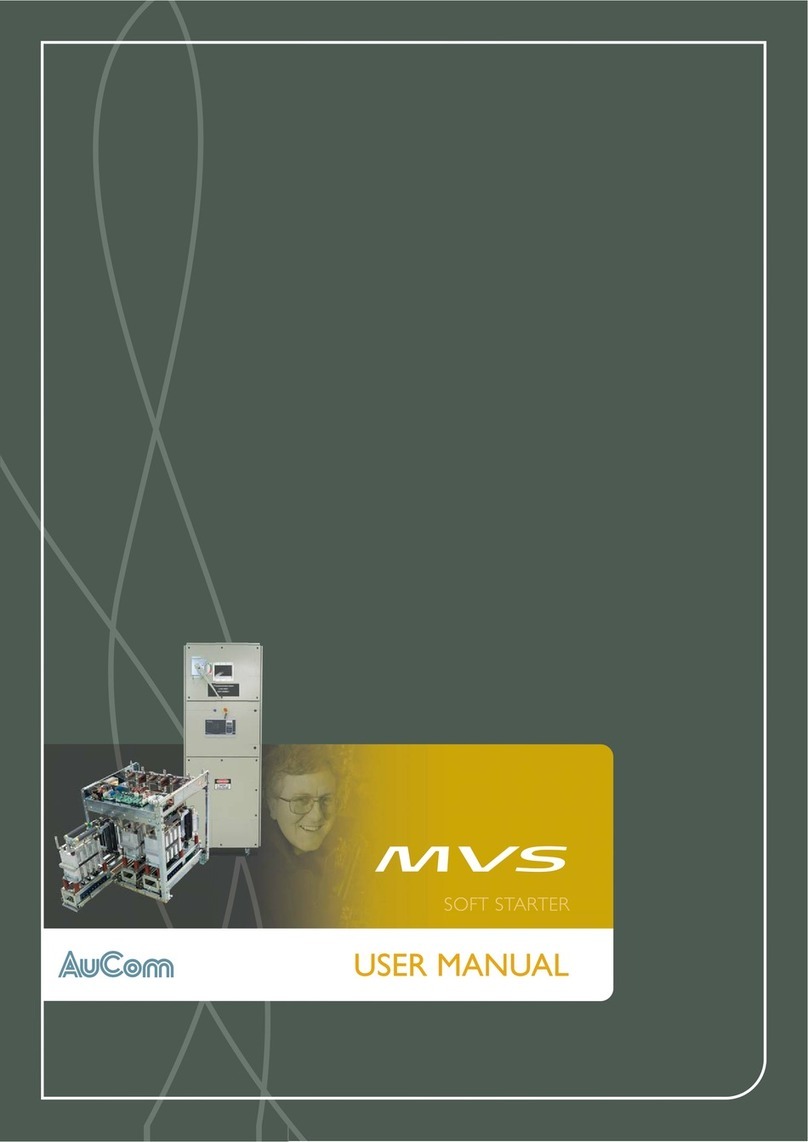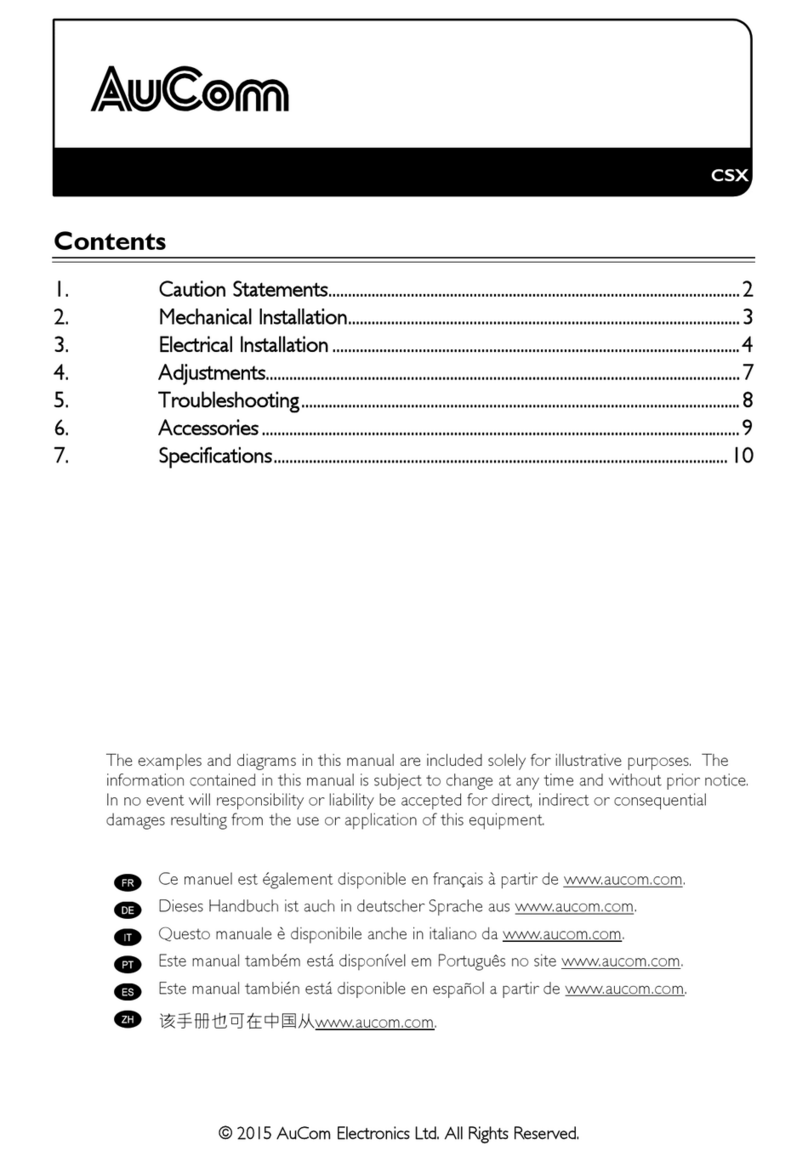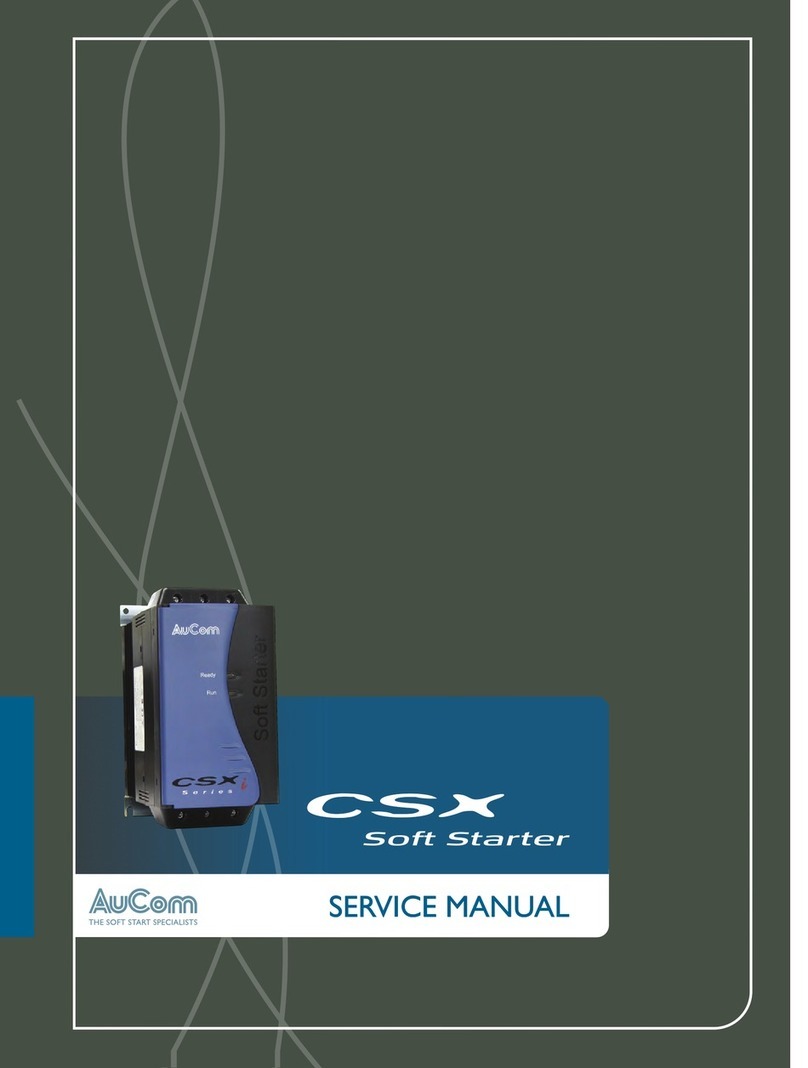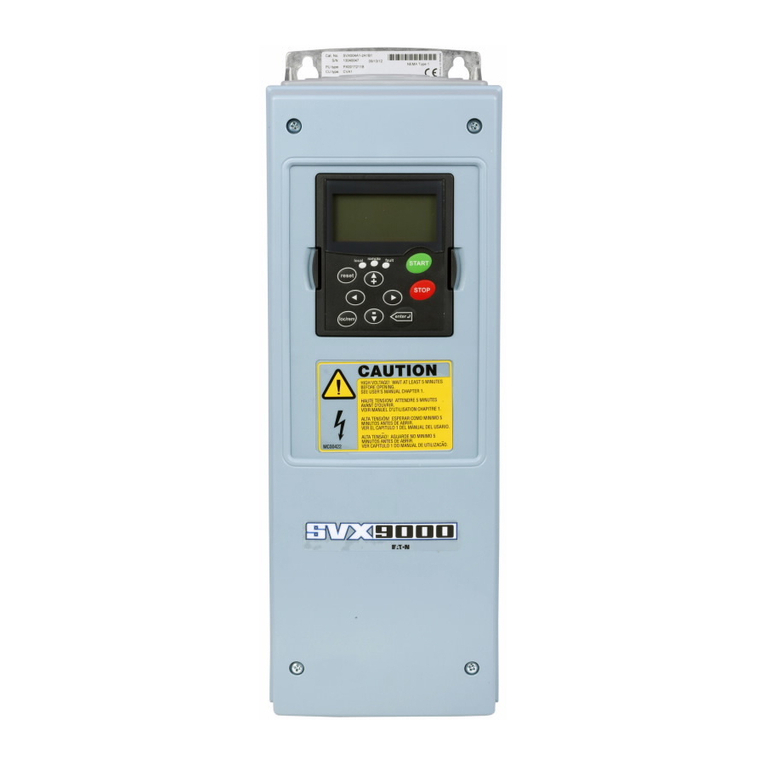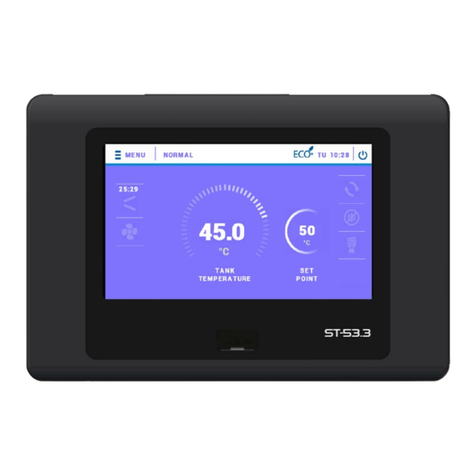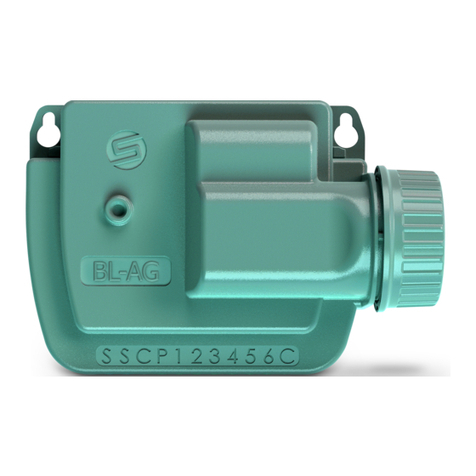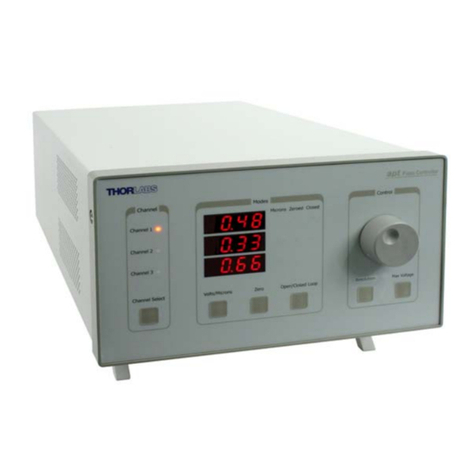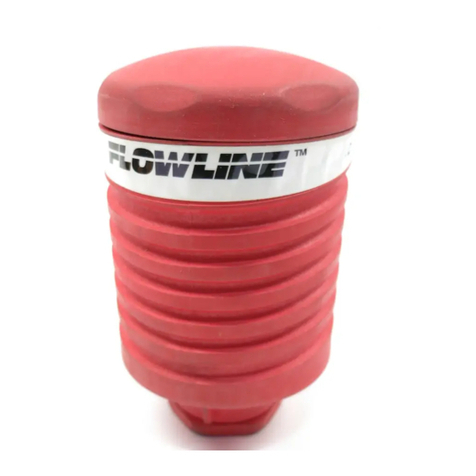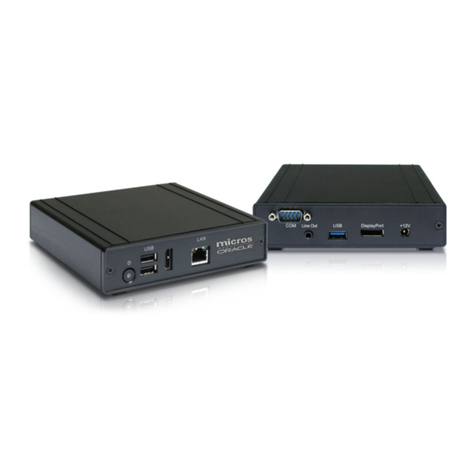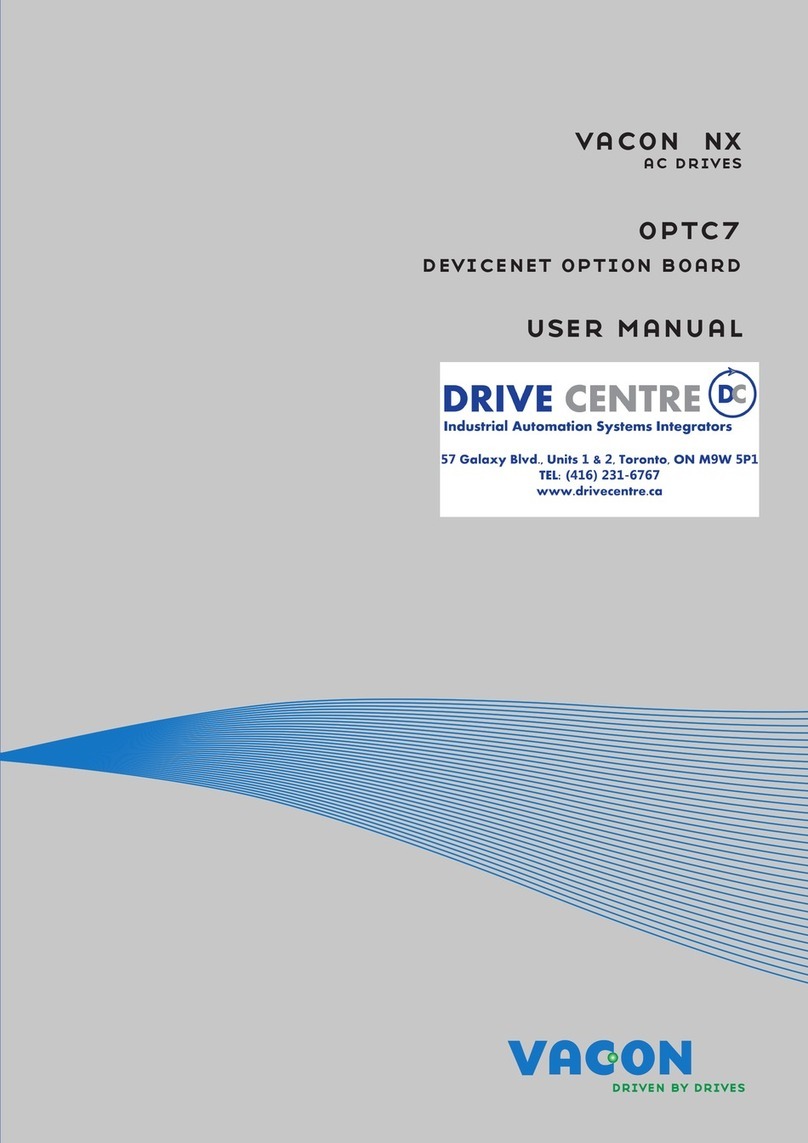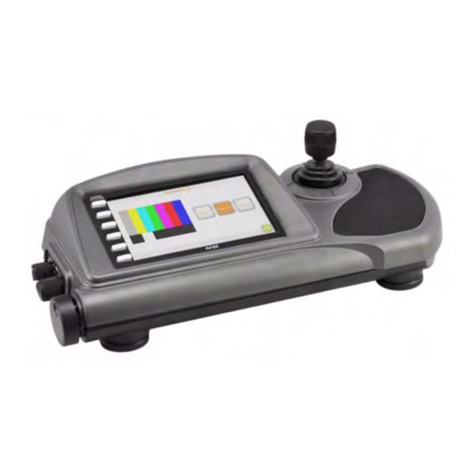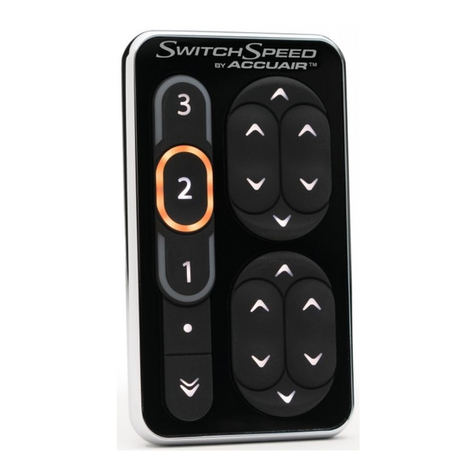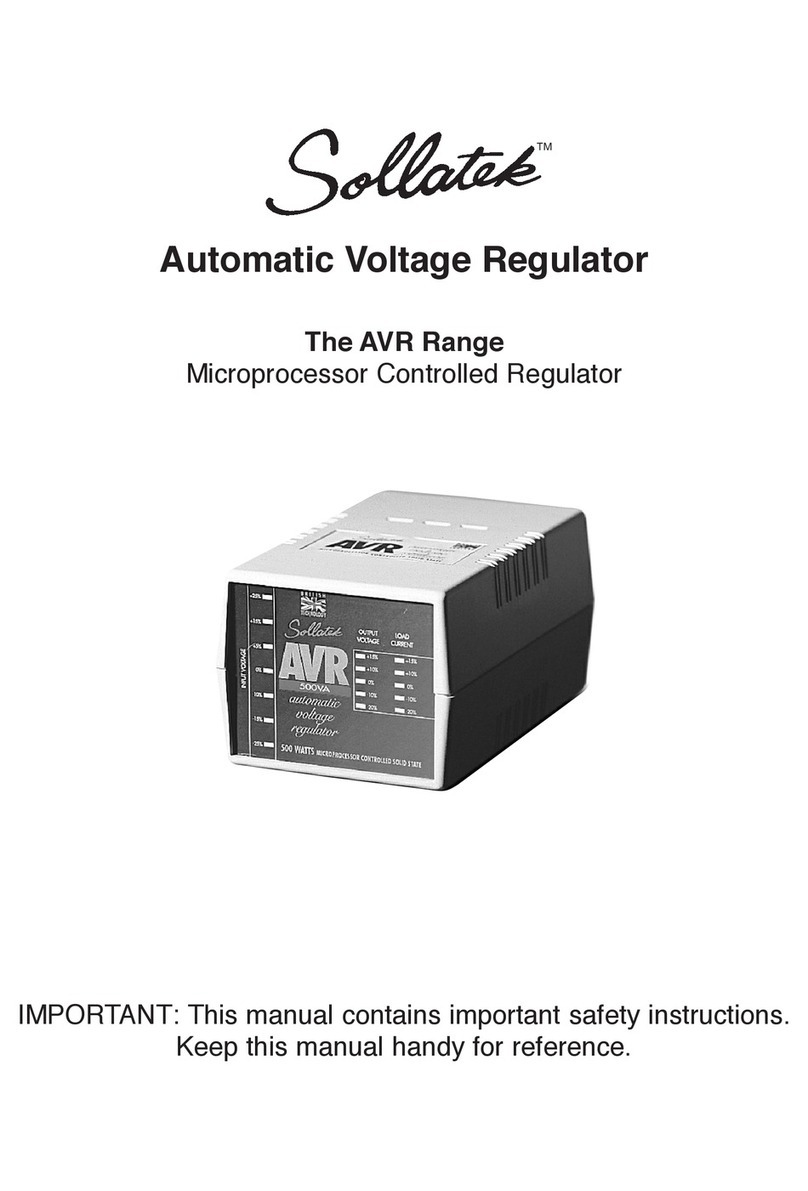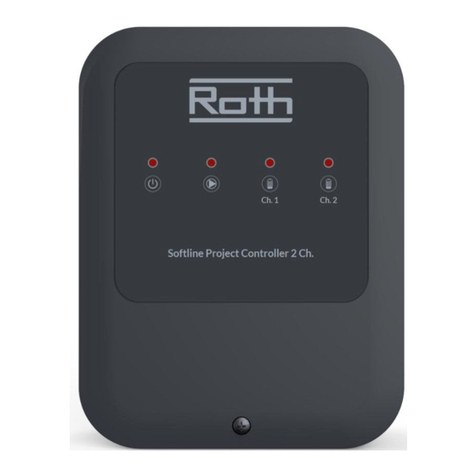AuCom MVE series User manual

New Zealand
123 Wrights Road, PO Box 80208, Christchurch 8440, New Zealand
T +64 3 338 8280 F +64 3 338 8104
China
203-1 JH Plaza, 2008 Huqingping Road, Shanghai 201702, China
T +86 21 5877 5178 F +86 21 5877 6378
Germany
Borsigstraße 6, 48324 Sendenhorst, Germany
T +49 2526 93880 0 F +49 2526 93880 100
Middle East
Al Thanyah Fifth, Mazaya Business Avenue BB2, Jumeirah Lakes Towers, Dubai, UAE
T +971 4 430 7203
North America
2528 Lovi Road, Building 2-2A, Freedom, PA 15042, USA
T 855 928 2666 (855 AUCOM NA), +1 724 987 4952 F +1 724 510 3005
http://my.aucom.com
MVE Soft Starter
USER MANUAL

CONTENTS
Contents
1. About This Manual............................................ 2
1.1 User Manual Version ...............................................2
1.2 Related Documents .................................................2
2. Caution Statements.......................................... 3
3. General Description .........................................4
3.1 Overview ...................................................................4
3.2 Feature List..............................................................4
3.3 Key Features ............................................................5
3.4 Model Code...............................................................6
3.5 Accessories ..............................................................7
4. Specifications................................................... 8
5. Installation ..................................................... 11
5.1 Dimensions and Weights.......................................11
5.2 Terminations on the Power Interface Board ........12
5.3 Power Circuits........................................................14
5.4 Operation mode selector switch (S1) ....................17
6. Controller....................................................... 18
6.1 Controller...............................................................18
6.2 Terminal Block (controller)...................................18
6.3 Control Wiring........................................................18
6.4 Menu Shortcuts......................................................19
6.5 Using the Controller ..............................................19
6.6 Starter Status LEDs...............................................19
6.7 Displays ..................................................................20
6.8 Display Calibration.................................................21
6.9 Commissioning Menu (Tools)................................21
6.10 Set Date and Time..................................................22
6.11 Simulation Tools ....................................................22
6.12 Input/Output Status ...............................................26
6.13 Reset Thermal Models...........................................26
6.14 Monitoring..............................................................27
7. Operation........................................................ 28
7.1 Start, Stop and Reset Commands .........................28
7.2 Using the Soft Starter to Control a Motor.............28
7.3 Soft Start Methods.................................................28
7.4 Stop Methods .........................................................30
7.5 Operating States ....................................................31
8. Motor Protection ............................................ 32
8.1 Motor, System and Soft Starter Protection
Mechanisms...........................................................32
8.2 Protection Coordination ........................................32
8.3 Motor Overload Protection ....................................32
9. Programmable Parameters........................... 36
9.1 Programming Menu...............................................36
9.2 Standard Menu.......................................................37
9.3 Extended Menu.......................................................38
9.4 Parameter Descriptions ........................................42
10. Commissioning ...............................................57
10.1 Site Acceptance Test (SAT) Procedure .................57
10.2 Secondary injection testing ...................................62
10.3 Dielectric test on the main circuit.........................62
11. Troubleshooting .............................................65
11.1 Protection Responses............................................65
11.2 Trip Messages........................................................65
11.3 General Faults .......................................................69
12. Maintenance ...................................................71
12.1 Safety......................................................................71
12.2 Maintenance Schedule ..........................................71
12.3 Tools required........................................................71
12.4 Thermal Image.......................................................71
13. Appendix .........................................................72
13.1 Parameter Defaults ...............................................72
MVE User Manual (710-17074-00H) | 1

ABOUT THIS MANUAL
1. About This Manual
The examples and diagrams in this manual are included solely for illustrative purposes. The information contained in
this manual is subject to change at any time and without prior notice. In no event will responsibility or liability be
accepted for direct, indirect or consequential damages resulting from the use or application of this equipment.
WARNING
Indicates a hazard that may cause personal injury or death.
CAUTION
Indicates a hazard that may damage the equipment or installation.
NOTE
Provides helpful information.
1.1 User Manual Version
This user manual (710-17074-00H) is compatible with MVE soft starters using version 1.33 control software and
version 2.36 interface software. For other software versions, please contact AuCom for the correct user manual.
Software versions are displayed on the screen at power up.
Ready
Welcome
1.33 / 2.36 / 2.02
Software versions: Control software, interface software, keypad
1.2 Related Documents
This user manual describes the features and operation of MVE soft starters.
For detailed information on how to integrate or install the soft starter, contact your local supplier.
© 2019 AuCom Electronics Ltd. All Rights Reserved.
As AuCom is continuously improving its products it reserves the right to modify or change the specification of its
products at any time without notice. The text, diagrams, images and any other literary or artistic works appearing in
this document are protected by copyright.
Users may copy some of the material for their personal reference but may not
copy or use material for any other purpose without the prior consent of AuCom Electronics Ltd. AuCom endeavours to
ensure that the information contained in this
document including images is correct but does not accept any liability for
error, omission or differences with the finished product.
2| MVE User Manual (710-17074-00H)

CAUTION STATEMENTS
2. Caution Statements
Caution Statements cannot cover every potential cause of equipment damage but can highlight common causes of
damage. It is the installer's responsibility to read and understand all instructions in this manual prior to installing,
operating or maintaining the equipment, to follow good electrical practice including applying appropriate personal
protective equipment and to seek advice before operating this equipment in a manner other than as described in this
manual.
•Read and understand the entire manual before installing operating, or maintaining the MVE. Follow all
applicable local and national codes.
•Apply appropriate personal protective equipment (PPE) and clothing, and follow safe electrical work
practices.
•Disconnect all power and ensure that the MVE is de-energised before servicing the equipment.
•Do not rely on visual indications such as switch position or fuse removal for determining a de-energised
condition. Always assume that a terminal is energised until it is checked and ensure that a terminal is
de-energised and grounded.
•Isolate the MVE completely from the power supply before attempting any work on the MVE or motor.
•Always use a properly rated voltage sensing device to confirm power is off.
•Before servicing the MVE, ensure that all static charge has been discharged by grounding it with an
appropriate grounding device.
•Metal debris in the enclosure can cause equipment failure.
•The control inputs are powered by the soft starter. Do not apply external voltage to the control input
terminals.
•Contacts or switches operating the control inputs must be suitable for low voltage, low current
switching (ie gold flash or similar).
•Cables to the control inputs must be segregated from mains voltage and motor cabling.
•Some contactor coils are not suitable for direct switching with PCB mount relays.
WARNING - ELECTRICAL SHOCK HAZARD
The MVE contains dangerous voltages when connected to mains voltage. Only a qualified electrician should
carry out the electrical installation. Improper installation of the motor or the MVE may cause equipment
failure, serious injury or death. Follow this manual and local electrical safety codes.
SHORT CIRCUIT
The MVE is not short circuit proof. After severe overload or short circuit, the operation of the MVE should
be fully tested by an authorised service agent.
GROUNDING AND BRANCH CIRCUIT PROTECTION
It is the responsibility of the user or person installing the MVE to provide proper grounding and branch
circuit protection according to local electrical safety codes.
ARC FLASH HAZARD
Medium voltage equipment has a potential risk of arc flash. When insulation or isolation between
electrified conductors is breached or can no longer withstand the applied voltage, a short circuit occurs
through the air. This may cause a phase-to-ground and/or a phase-to-phase fault.
Although unlikely, arc fault can be caused by:
•Contamination in the insulation caused by deterioration over time
•Inadequate insulation system on cable terminals
•Overvoltage
•Incorrect protection coordination settings
•Overheating of the contact area, due to incorrect tightening of connections
•Foreign matter, such as metal debris, vermin, tools or maintenance equipment left in the starter
AuCom medium voltage equipment has been designed to mitigate an arc fault, however it is the
responsibility of the site engineer to ensure that personnel are protected from serious injury that may
result from an arc fault.
MVE User Manual (710-17074-00H) | 3

GENERAL DESCRIPTION
3. General Description
3.1 Overview
The MVE provides compact and robust soft start solutions for control of medium voltage motors. MVE soft starters
provide a complete range of motor and system protection features and have been designed for reliable performance
in the most demanding installation situations.
The main components of a MVE soft starter are:
•Power assembly (3 x phase arms)
•Multilingual controller with fibre-optic cables
•Power interface board, including diagnostic board
•3 x CTs – 1000:1
3.2 Feature List
Versatile starting and stopping options
•Constant current
•Current ramp
•Timed voltage ramp start
•Coast To Stop
•Timed voltage ramp soft stop
Protection
•Undervoltage / Overvoltage (27, 59)
•Mains frequency (81)
•Phase loss (47)
•Phase sequence (47)
•Shorted SCR (3)
•Motor Overload (thermal model) (49, 51)
•Instantaneous Overcurrent (two stages) (50, 51)
•Time-overcurrent (51)
•Ground Fault (50G)
•Undercurrent (37)
•Current Imbalance (46, 60)
•Motor thermistor (26, 49)
•Excess Start Time (48)
•Power circuit / Power loss (32)
•Input Trip (94, 95)
•Internal/external communications failure (85)
Extensive input and output options
•Remote control inputs
(3 x fixed, 2 x programmable)
•Relay outputs
(4 x fixed, 3 x programmable)
•Analog output
(1 x programmable)
•Serial port (with module)
Comprehensive feedback
•Starter status LEDs
•Date and time stamped event logging
•Operational counters (number of starts,
hours-run, kWh)
•Performance monitoring (current, voltage,
power factor, kWh)
•User-programmable monitoring screen
•Multi-level password protection
Accessories (optional)
•Communication modules: Ethernet (Profinet,
Modbus TCP, Ethernet/IP), Profibus, DeviceNet,
Modbus RTU, and USB
4| MVE User Manual (710-17074-00H)

GENERAL DESCRIPTION
3.3 Key Features
MVE soft starters are designed to ensure reliable, user-friendly operation, and easy installation and maintenance.
•Versatile starting and stopping options
•A range of starting methods including current based torque control make the MVE soft starter suitable
for all applications.
•Dual motor sets allow you to configure two different starting and stopping profiles.
•Customisable protection
•Intelligent thermal modelling allows the soft starter to dynamically calculate motor temperature and
determine whether the motor can start successfully.
•A wide range of protection features including ground fault protection ensure that your equipment can
operate safely even in the most demanding environments.
•Using DOL+ Mode, the soft starter protects your motor and system even if the starter is bypassed.
•All protections can be customised to suit the needs of the application.
•Personnel safety
•Interface Board Technology (IBT) isolates the core starter control system and controller from the MV
power section, creating a safer work environment.
•Simple commissioning
•Simulation mode lets you quickly and easily test the interaction between the starter and other system
components, without connecting to a motor or mains supply.
•Use low voltage motor test to test the entire system without the need for a medium voltage motor or
supply.
•Secondary injection testing allows full testing of motor protections via an external system such as
Omicron.
•Easy to maintain
•Real-time graphs of motor performance and current quickly and clearly illustrate how your motor is
performing.
•A dedicated diagnostic capability records waveforms, to help diagnose conditions that are interfering
with operation
•Comprehensive Event and Trip Logging
•The MVE has a 99-place event log to record information on soft starter operation. A separate trip log
stores detailed information about the last eight trips. Refer to
Starter Trip and Event Logger Software
on
page 7for details. For further information, or to download the software, visit www.aucom.com.
•Informative Feedback Screens
•A digital display screen allows the MVE to display important information clearly. Comprehensive
metering information, details of starter status and last start performance allow easy monitoring of the
starter's performance at all times.
MVE User Manual (710-17074-00H) | 5

GENERAL DESCRIPTION
3.4 Model Code
MVE-
–
–
Control Voltage
C12 = 85 ~ 264 VAC or 90 ~ 350 VDC*
Supply Voltage
V02 = 2300 VAC 50/60 Hz
V03 = 3300 VAC 50/60 Hz
V04 = 4160 VAC 50/60 Hz
V06 = 6600 VAC 50/60 Hz
V11 = 11000 VAC 50/60 Hz
V13 = 13800 VAC 50/60 Hz
Current Rating @ AC53b 4-30 : 1770
0070 = 70 A 0700 = 700 A
0110 = 110 A 0800 = 800 A
0200 = 200 A 0900 = 900 A
0220 = 220 A 1000 = 1000 A
0250 = 250 A 1100 = 1100 A
0300 = 300 A 1200 = 1200 A
0360 = 360 A 1300 = 1300 A
0400 = 400 A 1400 = 1400 A
0450 = 450 A 1500 = 1500 A
0500 = 500 A 1600 = 1600 A
0540 = 540 A 1700 = 1700 A
0600 = 600 A
* Control voltage input range using an approved switch mode power supply unit with 24 VDC, 10 A (minimum) output
capacity.
6| MVE User Manual (710-17074-00H)

GENERAL DESCRIPTION
3.5 Accessories
Communication Interfaces
MVE soft starters support network communication via easy-to-install communications interfaces. Each soft starter
can support one communications interface at a time.
Available protocols:
Ethernet (Profinet, Modbus TCP, Ethernet/IP), Profibus, DeviceNet, Modbus RTU, and USB.
Protocol
Order code
Ethernet/IP PIM-EI-01
DeviceNet PIM-DN-01
Modbus RTU PIM-MB-01
Modbus TCP PIM-MT-01
Profibus PIM-PB-01
Profinet PIM-PN-01
USB PIM-USB-01
•Installing Communication Modules
Communication modules attach to the back of the controller:
LV motor test resistor assembly
LV motor test resistor assemblies are used for low voltage motor testing. They reduce the resistance across a phase
arm, increasing the strength of the non-conduction feedback signals. For more information, refer to
Low Voltage Test
Mode
on page 59.
Starter Trip and Event Logger Software
The Starter Trip and Event Logger Software allows you to download the trip and event logs from the soft starter, for
separate analysis.
The software is compatible with all AuCom medium voltage soft starters using control software version 1.29 or later.
To use the Starter Trip and Event Logger Software with the MVE, the soft starter must be fitted with a USB Module
(PIM-USB-01) or a Modbus Module (PIM-MB-01).
For further information, or to download the software, visit www.aucom.com.
MVE User Manual (710-17074-00H) | 7

SPECIFICATIONS
4. Specifications
Supply
Mains Voltage (Ur)
MVE-xxxx-V02 ................................................................................................................ 2.3 kV Phase-phase
MVE-xxxx-V03 ................................................................................................................ 3.3 kV Phase-phase
MVE-xxxx-V04 .............................................................................................................. 4.16 kV Phase-phase
MVE-xxxx-V06 ................................................................................................................ 6.6 kV Phase-phase
MVE-xxxx-V11 .............................................................................................................. 11.0 kV Phase-phase
MVE-xxxx-V13 .............................................................................................................. 13.8 kV Phase-phase
Rated Frequency (fr) .............................................................................................................................. 50/60 Hz
Rated lightning impulse withstand voltage (Up) 1
MVE-xxxx-V02 ~ V04 .............................................................................................................................. 40 kV
MVE-xxxx-V06 ........................................................................................................................................ 60 kV
MVE-xxxx-V11 ........................................................................................................................................ 75 kV
MVE-xxxx-V13 ........................................................................................................................................ 95 kV
Rated power frequency withstand voltage (Ud) 1
MVE-xxxx-V02 ~ V04 .............................................................................................................................. 10 kV
MVE-xxxx-V06 ........................................................................................................................................ 20 kV
MVE-xxxx-V11 ........................................................................................................................................ 42 kV
MVE-xxxx-V13 ........................................................................................................................................ 38 kV
Rated normal current (lr)
MVE-0070-Vxx ........................................................................................................................................ 70 A
MVE-0110-Vxx ...................................................................................................................................... 110 A
MVE-0200-Vxx ...................................................................................................................................... 200 A
MVE-0220-Vxx ...................................................................................................................................... 220 A
MVE-0250-Vxx ...................................................................................................................................... 250 A
MVE-0300-Vxx ...................................................................................................................................... 300 A
MVE-0360-Vxx ...................................................................................................................................... 360 A
MVE-0400-Vxx ...................................................................................................................................... 400 A
MVE-0450-Vxx ...................................................................................................................................... 450 A
MVE-0500-Vxx ...................................................................................................................................... 500 A
MVE-0540-Vxx ...................................................................................................................................... 540 A
MVE-0600-Vxx ...................................................................................................................................... 600 A
MVE-0700-Vxx ...................................................................................................................................... 700 A
MVE-0800-Vxx ...................................................................................................................................... 800 A
MVE-0900-Vxx ...................................................................................................................................... 900 A
MVE-1000-Vxx .................................................................................................................................... 1000 A
MVE-1100-Vxx .................................................................................................................................... 1100 A
MVE-1200-Vxx .................................................................................................................................... 1200 A
MVE-1300-Vxx .................................................................................................................................... 1300 A
MVE-1400-Vxx .................................................................................................................................... 1400 A
MVE-1500-Vxx .................................................................................................................................... 1500 A
MVE-1600-Vxx .................................................................................................................................... 1600 A
MVE-1700-Vxx .................................................................................................................................... 1700 A
Form designation .................................................................... Bypassed semiconductor motor starter form 1
Control voltage ................................................................................................... 85 ~ 264 VAC or 90 ~ 350 VDC 2
Typical power consumption
During Start (Control supply) .............................................................................................................≤ 150 W
During Run ....................................................................................................................... 70 W continuous 3
8| MVE User Manual (710-17074-00H)

SPECIFICATIONS
Inputs
Inputs on Controller
Start (C23, C24) ................................................................................................................... 24 VDC, 8 mA approx
Stop (C31, C32) ................................................................................................................... 24 VDC, 8 mA approx
Reset (C41, C42) ................................................................................................................. 24 VDC, 8 mA approx
Input A (C53, C54) ............................................................................................................... 24 VDC, 8 mA approx
Input B (C63, C64) ............................................................................................................... 24 VDC, 8 mA approx
Motor thermistor (B4, B5) ...................................................................................................... Trip point > 3.6 kΩ
........................................................................................................................................................... Reset > 1.6 kΩ
Inputs on power interface board
Bypass readback input (C73, C74) ..................................................................................... 24 VDC, 8 mA approx
Fan Fail (C1, C2) ................................................................................................................. 24 VDC, 8 mA approx
DOL protection activated (C3, C4) ...................................................................................... 24 VDC, 8 mA approx
Power supply fail input (C5, C6) ......................................................................................... 24 VDC, 8 mA approx
NOTE
All control inputs are potential free. Do not apply external voltage to these inputs.
Outputs
Outputs on Controller
Output Relay A (43, 44) ......................................................................................................... Normally Open
Output Relay B (51, 52, 54) ........................................................................................................ Changeover
Output Relay C (61, 62, 64) ........................................................................................................ Changeover
Analog output (B10, B11) ............................................................................................. 0-20 mA or 4-20 mA
Ratings of output relays on Controller
................................................................................................................................. 10 A @ 250 VAC resistive
................................................................................................................................. 6 A @ 250 VAC 15 p.f. 0.3
................................................................................................................................... 10 A @ 30 VDC resistive
Outputs on power interface board
Main contactor (13, 14) ........................................................................................................ Normally Open
Bypass contactor (23, 24) .................................................................................................... Normally Open
Run Output/ PFC (33, 34) ..................................................................................................... Normally Open
Phase arm power supply control relay output (43, 44) ...................................................... Normally Open
Ratings of output relays on power interface board
................................................................................................................................. 10 A @ 250 VAC resistive
................................................................................................................................... 10 A @ 30 VDC resistive
Environmental
Degree of Protection
Power Assembly .................................................................................................................................... IP00
Controller .............................................................................................................................. IP54/ NEMA 12
Operating temperature ............................................................ - 10 ˚C to + 60 °C, above + 50 °C with derating
Humidity ............................................................................................................ 5%~95% Relative Humidity
Storage temperature .............................................................................................................. - 25 ˚C to + 70 ˚C
Humidity ............................................................................................................ 5%~95% Relative Humidity
Operating Altitude ................................................................................. 0~1000 m, above 1000 m with derating
Pollution degree .................................................................................................................... Pollution Degree 3
Vibration ............................................................................................................. Designed to IEC 60068-2-6-Fc
MVE User Manual (710-17074-00H) | 9

SPECIFICATIONS
EMC Emission (Designed to IEC 60947-4-2)
Equipment class (EMC) ............................................................................................................................ Class A
Conducted radio frequency emission ............................................................. 0.15 MHz to 0.5 MHz: < 79 dB µV
.................................................................................................................................. 0.5 to 5 MHz: < 73 dB µV
................................................................................................................................... 5 to 30 MHz: < 73 dB µV
Radiated radio frequency emission ...................................................................... 30 to 230 MHz: < 30 dB µV/m
.............................................................................................................. 230 MHz to 1000 MHz: < 37 dB µV/m
This product has been designed as Class A equipment. Use of this product in domestic environments may cause radio
interference, in which case the user may be required to employ additional mitigation methods.
EMC Immunity (Designed to IEC 60947-4-2)
Electrostatic Discharge .................................................................. 6 kV contact discharge, 8 kV air discharge
Radio Frequency Electromagnetic Field ....................................................................... 80 to 1000 MHz: 10 V/m
Fast Transients 5/50 ns (main and control circuits) .................................... 2 kV line to earth, 1 kV line to line
Surges 1.2/50 µs (main and control circuits) ............................................... 2 kV line to earth, 1 kV line to line
Voltage dip and short time interruption (safe shutdown) ............................. 5000 ms (at 0% nominal voltage)
Certification
UL (models ≤4.2 kV only) .......................................................................................................... UL 347, 6th edition
1Higher ratings may be available on request.
2Control voltage input range using an approved switch mode power supply unit with 24 VDC, 10 A (minimum) output
capacity.
3Excludes contactors and/or circuit breakers.
10 | MVE User Manual (710-17074-00H)

INSTALLATION
5. Installation
5.1 Dimensions and Weights
B
B
A
C
Front view Side view
A
B
C
D
Weight
(phase arm)
mm (inch)
mm (inch)
mm (inch)
mm (inch)
kg (lb)
MVE-V02: 0070~0450
750
(29.5)
246
(9.7)
584
(23.0)
508
(20.0)
38.4 (84.7)
MVE-V03: 0070~0450 39.5 (87.1)
MVE-V04: 0070~0450
MVE-V06: 0070~0450
652 (25.7)
600 (23.6)
53.3 (117.5)
MVE-V02: 0500~0540
750
(29.5)
246
(9.7)
584
(23.0)
600
(23.6)
38.4 (84.7)
MVE-V03: 0500~0540 39.5 (87.1)
MVE-V04: 0500~0540
MVE-V06: 0500~0540
652 (25.7)
660 (26.0)
58.9 (127.9)
MVE-V11: 0070~0540 978 (38.5) 308
(12.1)
1000 (39.4) 602 (23.7) 105 (231.5)
MVE-V13: 0070~0540 1048 (41.3) 1100 (43.3) 764 (30.1) 125 (275.6)
Packaging dimensions and weights
The weight values are indicative only and include the soft starter or phase arm but not other related components.
Individual phase arm
Complete power assembly
Width
Height
Depth
Weight
Width
Height
Depth
Weight
mm (inch) mm (inch) mm (inch) kg (lb) mm (inch) mm (inch) mm (inch) kg (lb)
MVE-V02
MVE-V03 352 (13.9) 625 (24.6) 862 (33.9) 60 (132.3) 882 (34.7) 625 (24.6) 862 (33.9) 165 (363.8)
MVE-V04
MVE-V06 352 (13.9) 715 (28.1) 862 (33.9) 76 (167.6) 950 (37.4) 715 (28.1) 862 (33.9) 210 (463.0)
MVE-V11 400 (15.7) 650 (25.6) 1050 (41.3) 140 (308.6) 1250 (49.2)
650 (25.6) 1050 (41.3) 370 (815.7)
MVE-V13 554 (21.8) 823 (32.4) 1050 (41.3) 165 (363.8) 1404 (55.3)
823 (32.4) 1050 (41.3) 470 (1036)
MVE User Manual (710-17074-00H) | 11

INSTALLATION
5.2 Terminations on the Power Interface Board
12 | MVE User Manual (710-17074-00H)

INSTALLATION
1
CT ratio selector DIP switch S1
2
Non-conduction LEDs (green)
3
Gate firing fibre-optic connectors
4
Firing status LEDs (red)
5
Earth termination point (for voltage sensing ground connections)
6
Voltage sensing input connector (V0 ~ V3)
7
Ground fault CT connector (GF1, GF2)
8
Line CT connectors (CT1 [L11/L12], CT2 [L21/L22], CT3 [L31/L32])
9
Non-conduction readback fibre-optic connectors
10
Fan Fail (C1, C2), DOL protection activated (C3, C4) and Power supply fail input (C5, C6)
11
ID resistors
12
Serial number
13
Fibre-optic connections and LEDs to controller (Rx = Green, Tx = Red)
14
Control supply LED (green)
15
Phase arm power supply control relay output and LED (green)
16
PFC contactor relay output and LED (green)
17
Control terminals
C73, C74 Bypass readback input (BPR)
13, 14 Main device relay output (MC)
23, 24 Bypass device relay output (BC)
33, 34 PFC contactor relay output (PF)
43, 44 Phase arm power supply control relay output (PAPS) / Fan control relay output
V In (A1, A2) Control supply input
18
Bypass device relay output and LED (green)
19
Main device relay output and LED (green)
20
Bypass readback input and LED (green)
NOTE
The fan fail (C1, C2) and power supply fail (C5, C6) inputs are wire linked.
MVE User Manual (710-17074-00H) | 13

INSTALLATION
5.3 Power Circuits
Overview
MVE soft starters are designed to operate as part of a system including other components.
•A bypass switching device (contactor or vacuum circuit breaker) is required in all installations.
•A main switching device (contactor or circuit breaker) is required in all installations. This can be located
in the soft starter panel or the upstream feeder panel.
•If contactors are used for one or both switching devices, appropriately rated fuses must be installed
upstream of the main switching device to provide short circuit protection if the short circuit level of the
network/supply is higher than the short circuit rating of the contactor.
Additional components may also be required to comply with soft starter panel specifications.
Main Switching Device
The MVE can be installed with a main contactor or a circuit breaker.
•Select a contactor with an AC3 rating greater than or equal to the full load current rating of the
connected motor.
•Select a circuit breaker greater than or equal to the full load current rating of the connected motor.
The main switching device is associated with terminals L1, L2, L3 on the supply side of the soft starter. The coil is
associated with output terminals 13, 14 of the MVE.
To ensure that the potentially dangerous medium voltage area is isolated from the low voltage control area, power is
supplied to the main switching device coil from the control voltage terminal block.
Bypass Switching Device
The MVE must always be installed with a bypass contactor or circuit breaker.
•Select a contactor with an AC3 rating greater than or equal to the full load current rating of the
connected motor.
•Select a circuit breaker greater than or equal to the full load current rating of the connected motor.
The bypass switching device is associated with terminals L1, L2, L3 on the supply side of the soft starter, and bypass
terminals T1B, T2B, T3B on the motor side. The coil is associated with output terminals 23, 24, and the auxiliary
Normally Open contact is associated with input terminals C73, C74 of the soft starter.
To ensure that the potentially dangerous medium voltage area is isolated from the low voltage control area, power is
supplied to the bypass switching device coil from the control voltage terminal block.
R Rated Protection Fuses
If contactors are used for one or both switching devices, appropriately rated fuses must be installed upstream of the
main switching device to provide short circuit protection if the short circuit level of the network/supply is higher than
the short circuit rating of the contactor. Select the appropriate fuse based on the motor's rated full load current.
Transient/ Overvoltage Protection
Overvoltage protection should be installed if there is a risk of high voltage transients at the installation. Contact your
local supplier for details.
Line Inductors
Output line inductors may be required depending on various factors, including the soft starter model, the system
operating voltage, the cable type, and the length of the cable run between the soft starter and the motor.
If required, line inductors are typically installed in a shielded caged enclosure at the soft starter end of the motor
cable.
To find out if line inductors are required for your specific installation, contact your local supplier for advice. You will
need to provide information about the motor output cable, including the cable length, cable type, and cable inductance
and capacitance per km.
14 | MVE User Manual (710-17074-00H)

INSTALLATION
Power Factor Correction
CAUTION
Power factor correction must be switched in using a dedicated contactor. Installing power factor correction
capacitors with no contactor may damage the soft starter.
Power factor correction capacitors should be selected based on the motor data and the required final power factor.
Select a contactor according to the required kVAr.
The soft starter must control the power factor correction capacitor contactor. Use the PFC output (terminals 33, 34 on
the power interface board).
19122.C
1
2
3
SST
1
Main switching device
2
Bypass switching device
3
PFC capacitor contactor
Capacitive surge arrestors
Capacitive surge arrestors are not compatible for use with soft starters. Using capacitive surge arrestors for motor
protection may damage the soft starter.
CAUTION
Capacitive surge arrestors may be mounted in the motor termination box. Check the motor datasheet and
check inside the termination box before connecting the soft starter. Disconnect any capacitive surge
arrestors.
SST
19108.B
1
2
3
1
Main switching device
2
Bypass switching device
3
Capacitive surge arrestor
MVE User Manual (710-17074-00H) | 15

INSTALLATION
Power Circuit Configuration
MVE power circuit with main contactor, bypass contactor, main isolator/ earth switch, R Rated fuses and current
transformers. When used with contactors, MVE must be installed with fuse if the short circuit level of the
network/supply is higher than the short circuit rating of the contactors.
L1 T1
P1 P2
S1 S2
P1 P2
P1 P2
S1 S2
S1 S2
L2 T2
L3 T3
L1
L2
L3
E
T1
T2
T3
K2
L3
L2
L1
T3
T2
T1
A1-1
A1-2
A1-3
K1
M
3
U1
V1
W1
F1
12
F2
1 2
F3
1 2
QM
L1A
L3A
T1
T2
T3
L1B
L2B
L3B
18050.B
L2A
L3
L2
L1
T3
T2
T1
CT3
CT2
CT1
2
1
3
4
56
7
1
Soft starter panel
L1-L3
Input power terminals (supply side)
A1-1 ~ A1-3
Phase arms 1 ~ 3
T1-T3 Output power terminals (motor side)
2
Current transformers
7
Fuses (F1-3)
3
Motor cables
K1 Main contactor
4
Three-phase supply
K2 Bypass contactor
5
Supply cables
6
Panel earth bar
QM Main isolator / Earth switch
disconnector
16 | MVE User Manual (710-17074-00H)

INSTALLATION
5.4 Operation mode selector switch (S1)
The MVE can soft start the motor, or can DOL start the motor with or without protection. Use the operation mode
selector switch (S1) to select the start mode.
SST position (soft start)
•The customer's external control signals start and stop the motor.
•The MVE performs a normal soft start.
•All soft starter protections are active.
•Relay outputs on the soft starter's power interface board control the line, bypass and PFC contactors.
DOL+ position (DOL with protection)
•The customer's external control signals start and stop the motor.
•The line and bypass contactors start the motor DOL.
•All soft starter protections are active.
•Relay outputs on the soft starter's power interface board control the line, bypass and PFC contactors.
NOTE
This mode allows the motor to be started when there is a fault with one of the soft starter phase arms. The
controller and power interface board must be in healthy working state.
DOL position (DOL without protection)
•The customer's external control signals start and stop the motor.
•The line and bypass contactors start the motor DOL.
•All soft starter protections are bypassed.
•The line and bypass contactors are controlled by the start and stop control signals.
•The PFC contactor (if used) must be controlled by a separate manual switch.
NOTE
This mode allows emergency operation of the motor when there is a major failure of any soft starter
component. Back-up fuses provide short circuit protection. Additional protections such as motor protection
or RTD overtemperature may be available if separate protection equipment is installed.
MVE User Manual (710-17074-00H) | 17

CONTROLLER
6. Controller
6.1 Controller
INP U TB
INP U TA
RESET
STOP
START
Run Trip Loc al
Ready
Exi t Me nu
Store
Logs Alt Tools
Reset LCL
RMT
StopStart
1
2
3
4
5
6
7
03913.B
1
Four-line display for status and
programming details.
5
Menu navigation buttons:
: Exit the menu or parameter, or cancel a parameter
change.
: Enter a menu or parameter, or save a parameter
change.
: Scroll to the next or previous menu or parameter,
or change the setting of the current parameter.
2
Status LEDs
3
Control input LEDs
4
Soft starter local control buttons
6
Shortcut buttons for quick access to common tasks.
7
Alt button. Use with F1 or F2 to open performance logs
or commissioning tools.
6.2 Terminal Block (controller)
Terminations on the controller use plug-in terminals. Unplug the terminal blocks, complete the wiring, then re-plug
the terminal blocks into the controller.
Output A
Output B
Output C
Motor
Thermistor
24 VAC/DC
Relay Outputs
Control
Supply Control Inputs
Fibre Optic Connection
To Power Assembly
Analog
Output
Start
Stop
Reset
Prog A
Prog B
03948.B
6.3 Control Wiring
The MVE has three fixed inputs for remote control. These inputs should be controlled by contacts rated for low
voltage, low current operation (gold flash or similar).
1
A
B
A B
C
A
B
C
C
23
C32
C31
C24
C23
C42
C41
03943.D
C32
C31
C24
C23
C42
C41
C32
C31
C24
C23
C42
C41
1
Two-wire control
2
Three-wire control
3
Four-wire control
A
Start
B
Stop
C
Reset
18 | MVE User Manual (710-17074-00H)

CONTROLLER
CAUTION
The control inputs are powered by the soft starter. Do not apply external voltage to the control input
terminals.
Cables to the control inputs must be segregated from mains voltage and motor cabling.
The reset input can be normally open or normally closed. Use parameter 6M to select the configuration.
NOTE
Reset input is normally closed by default.
6.4 Menu Shortcuts
The F1 and F2 buttons offer keyboard shortcuts to the Auto-Stop menu. Use parameters 8B and 8C (
8B, 8C – F1 and
F2 Button Action
on page 52) to select the shortcut target.
6.5 Using the Controller
Open menu
Select parameter
/
Confirm selection
Edit setting
/
Cancel or save
/
Edit more?
Finished?
Exit and close menu
6.6 Starter Status LEDs
LED name
On
Flashing
Ready The motor is stopped and the starter is ready to
start.
The motor is stopped and the starter is waiting for
the
Restart Delay
(parameter 4M) or
Motor
Temperature Check
(parameter 4N).
Run
The motor is in run state (receiving full voltage).
The motor is starting or stopping.
Trip
The starter has tripped.
The starter is in warning state.
Local
The starter is in Local control mode.
--
If the starter is in remote control mode, the Local LED will be off.
If all LEDs are off, the starter is not receiving control voltage.
NOTE
When the Controller is powered up, the Ready LED flashes for 5 seconds as part of the initialisation
routine.
MVE User Manual (710-17074-00H) | 19
Other manuals for MVE series
1
Table of contents
Other AuCom Controllers manuals
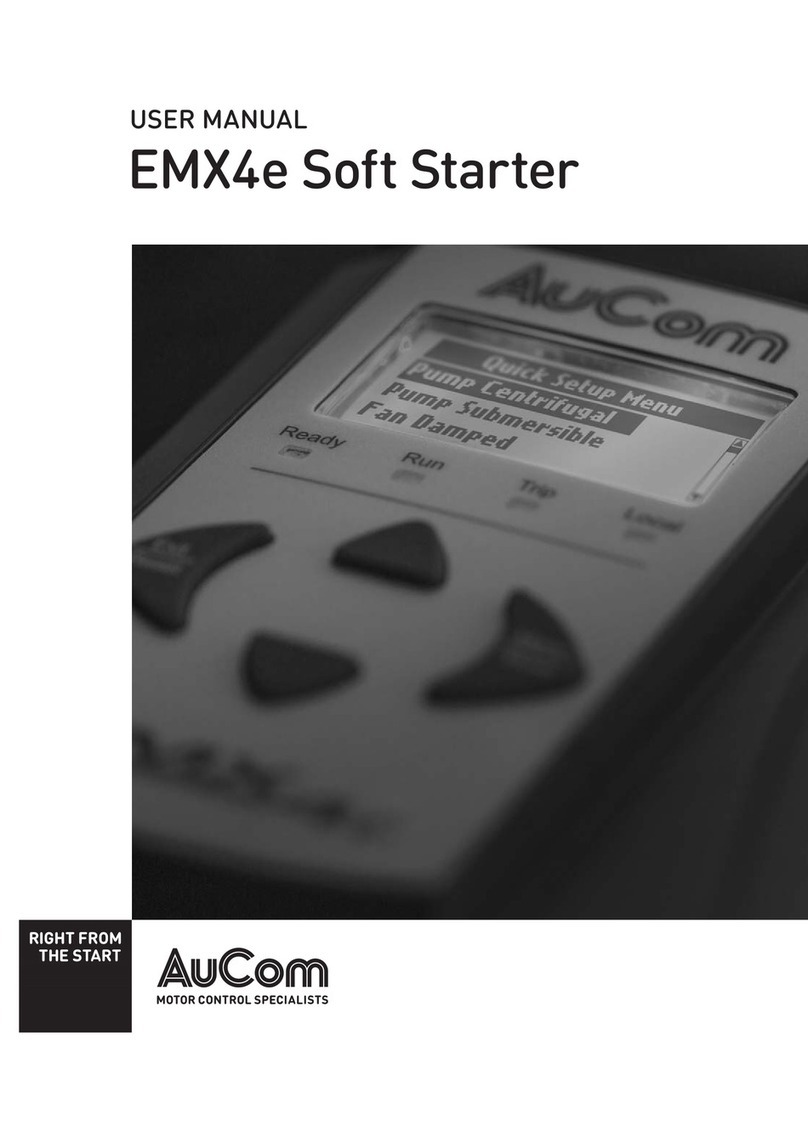
AuCom
AuCom EMXAe User manual
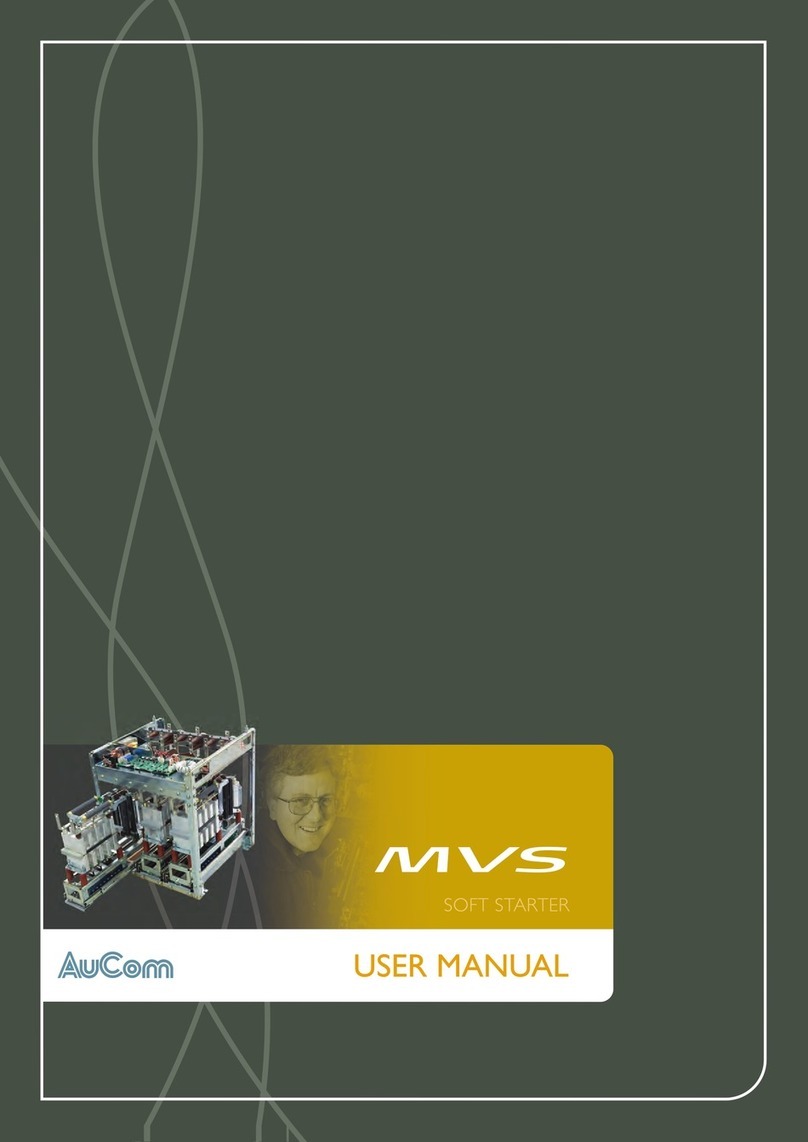
AuCom
AuCom MVS User manual
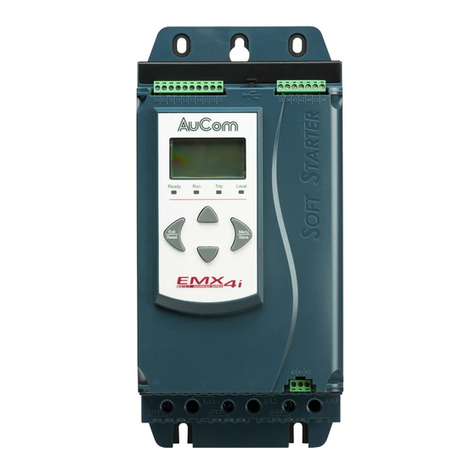
AuCom
AuCom EMX4i User manual
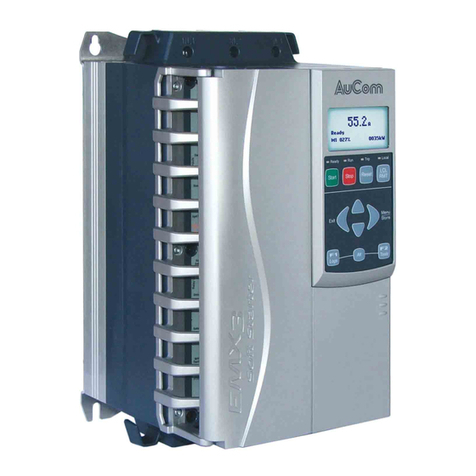
AuCom
AuCom EMX3-1600C User manual
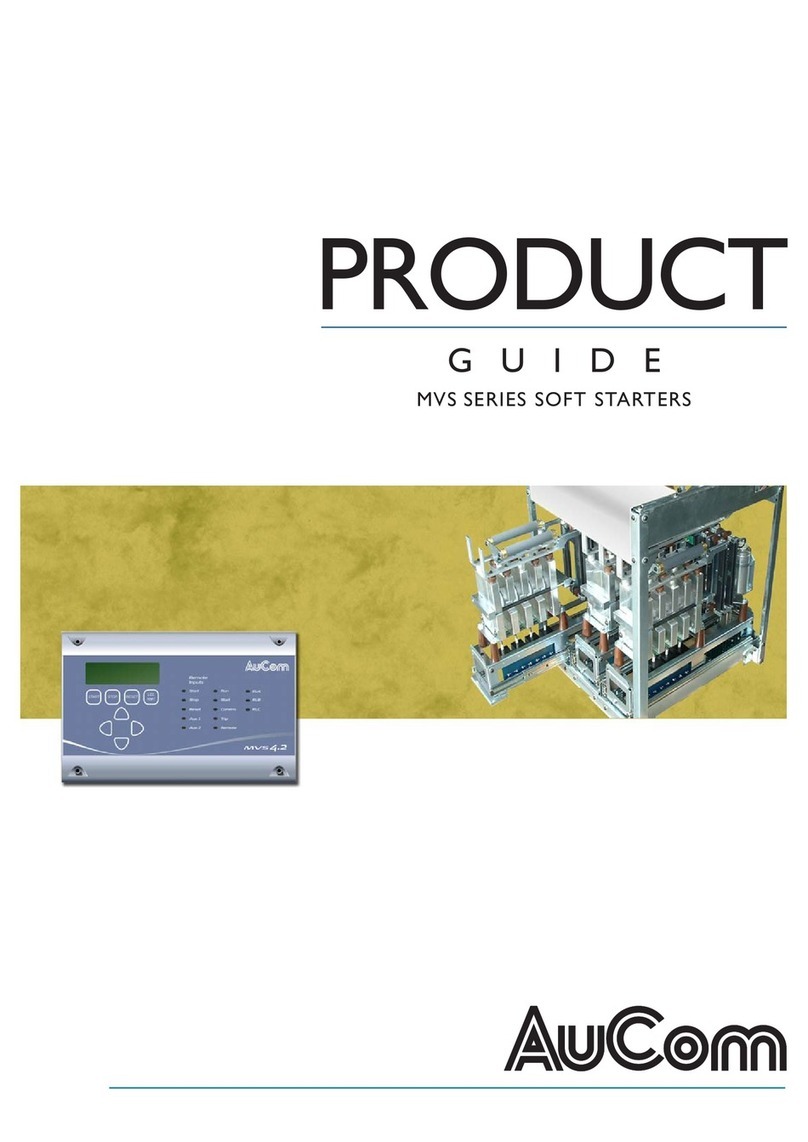
AuCom
AuCom MVS0080 User manual
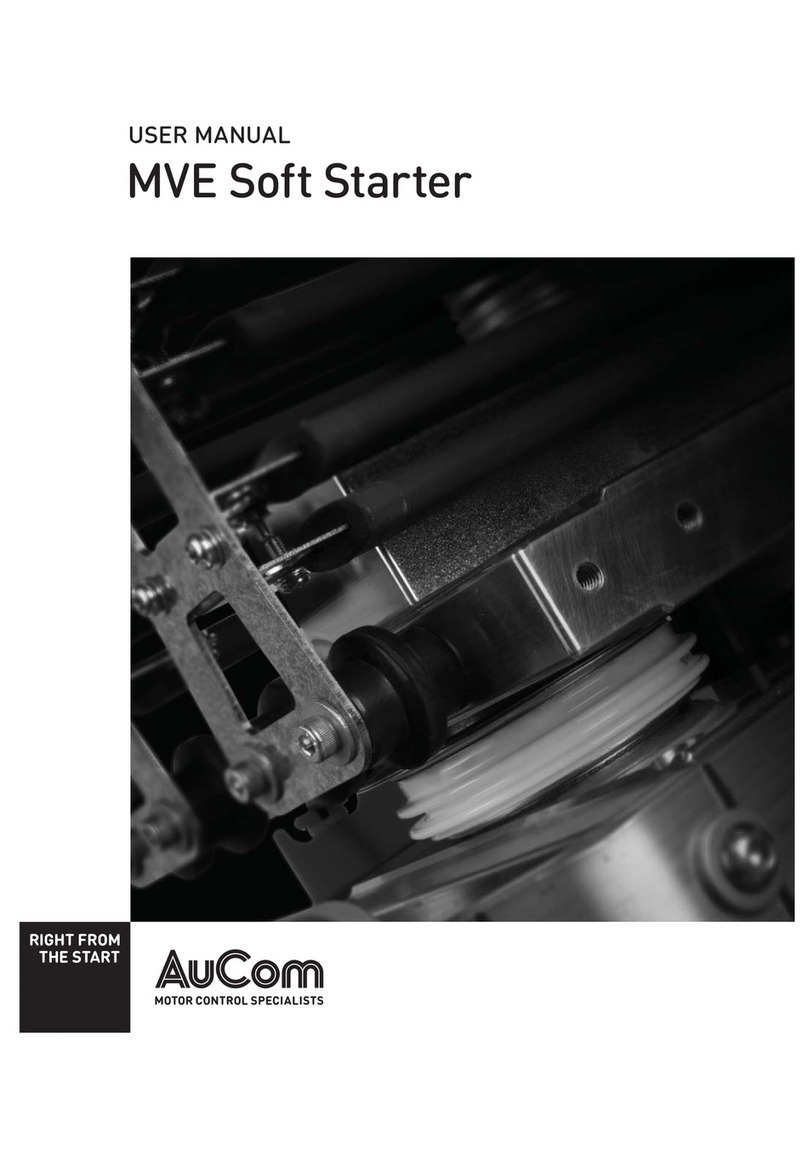
AuCom
AuCom MVE series User manual
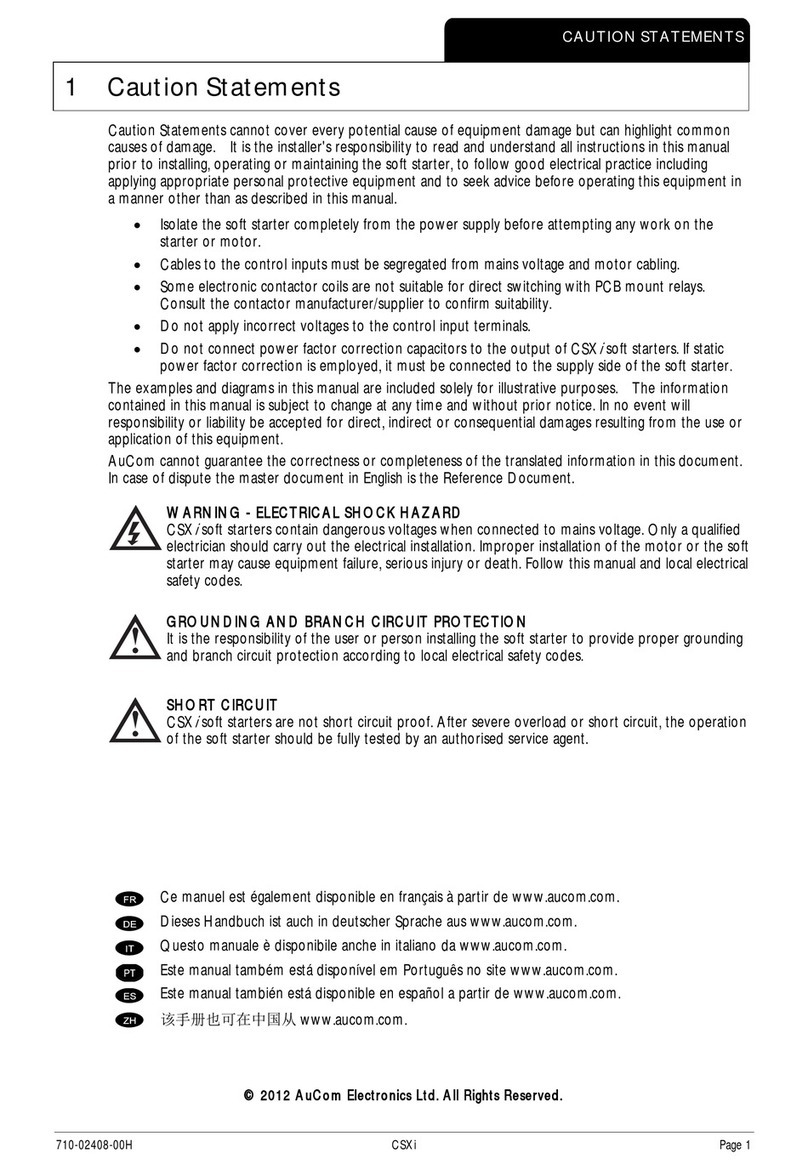
AuCom
AuCom CSXI-007 User manual
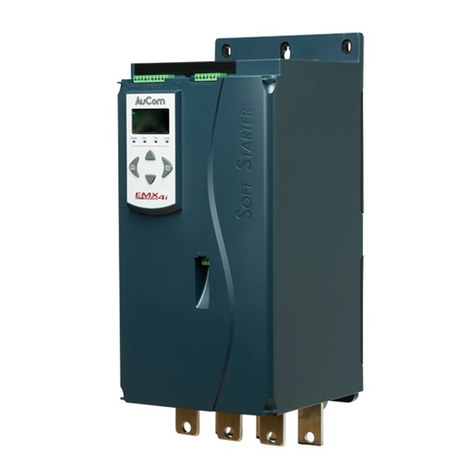
AuCom
AuCom Modbus RTU Card User manual
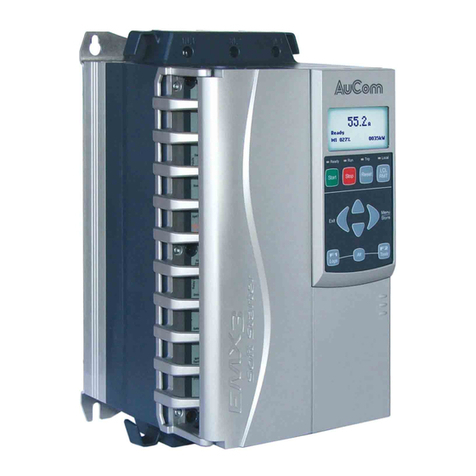
AuCom
AuCom EMX3 User manual
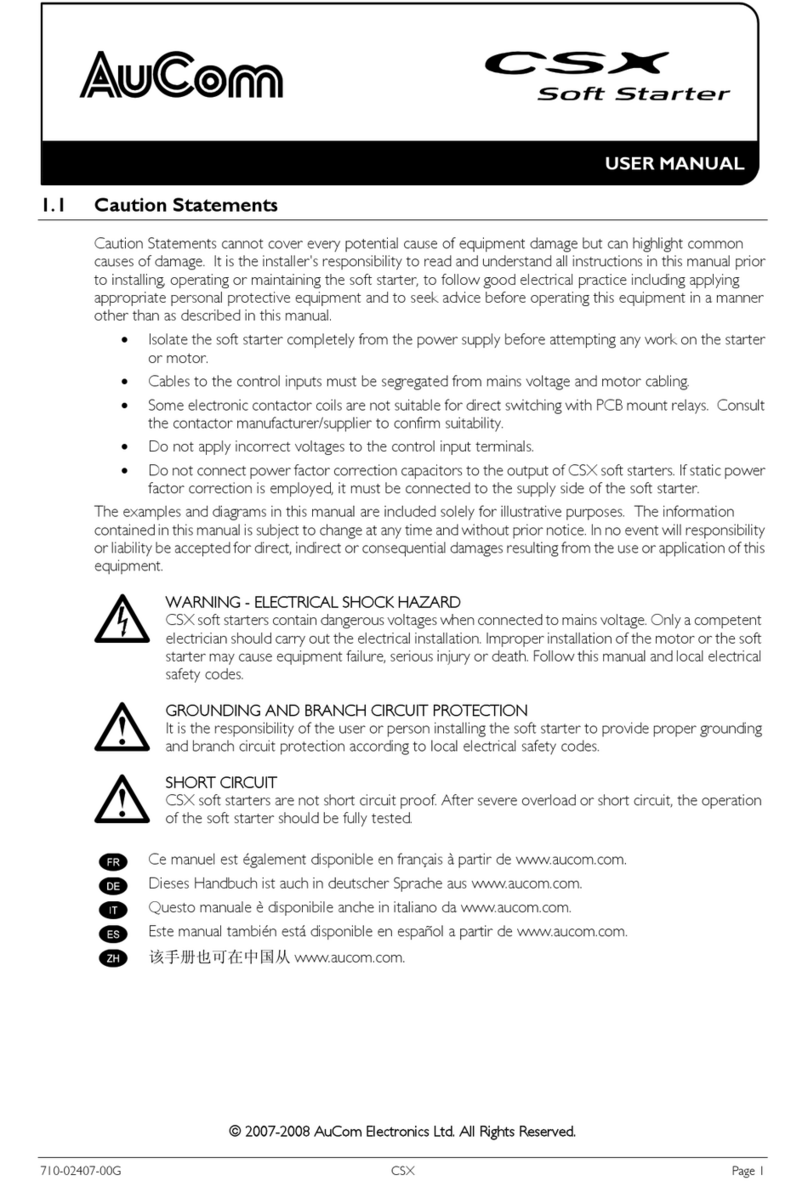
AuCom
AuCom CSX-007 User manual
Popular Controllers manuals by other brands
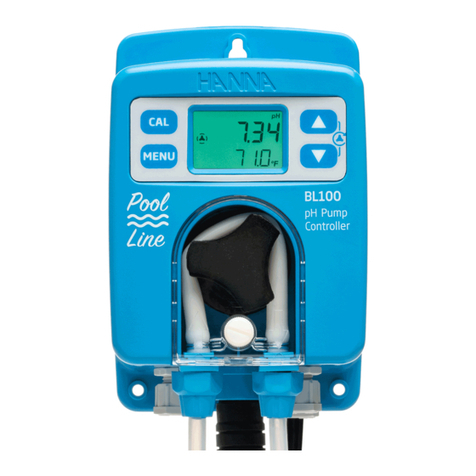
Hanna Instruments
Hanna Instruments BL100 Series instruction manual
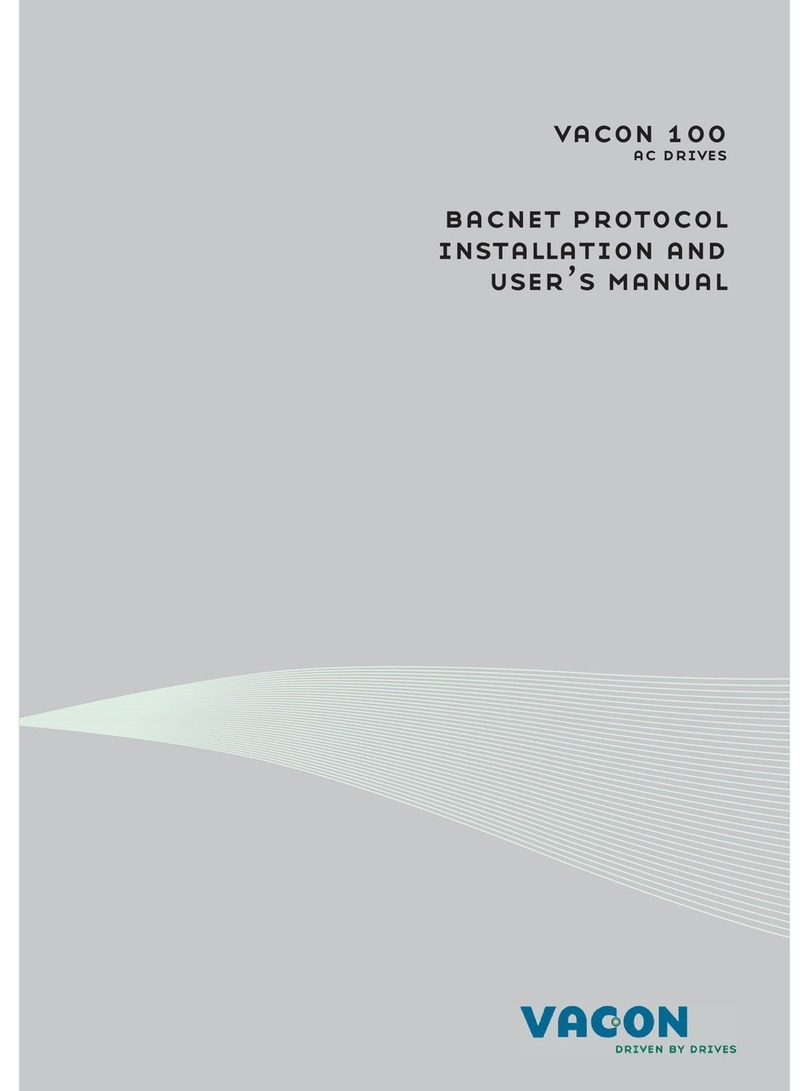
Vacon
Vacon 100 INDUSTRIAL Installation and user manual
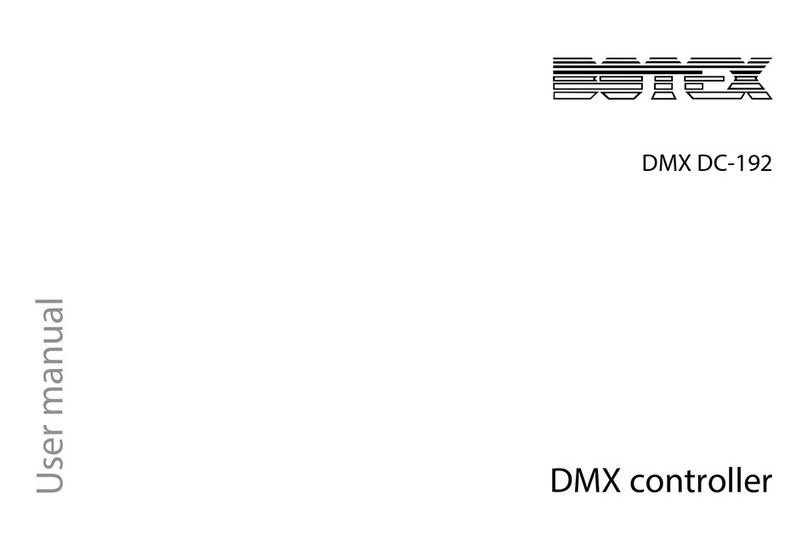
Botex
Botex DMX DC-192 user manual
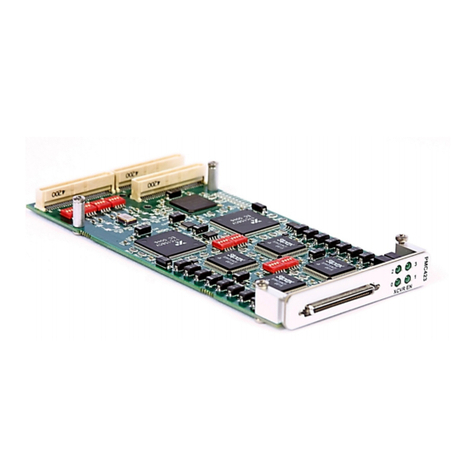
abaco systems
abaco systems PMC423 Hardware reference manual
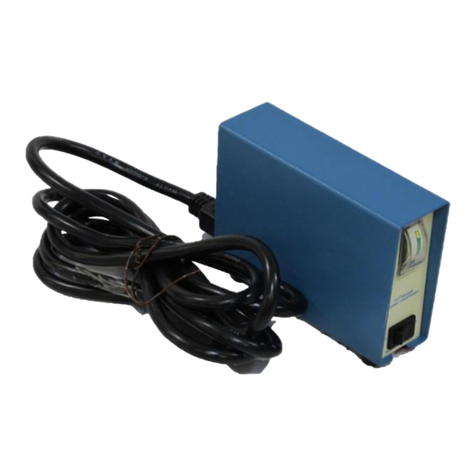
PCB Piezotronics
PCB Piezotronics 482B06 Installation and operating manual
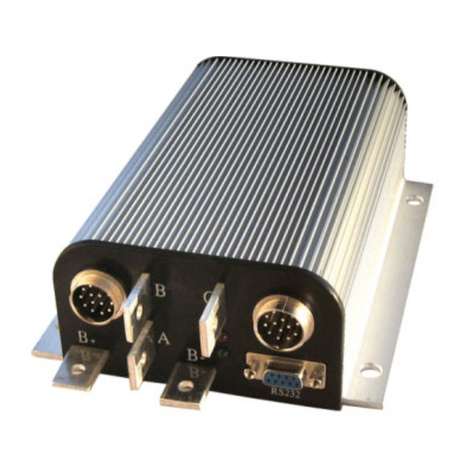
Kelly
Kelly KBL24101X user manual
